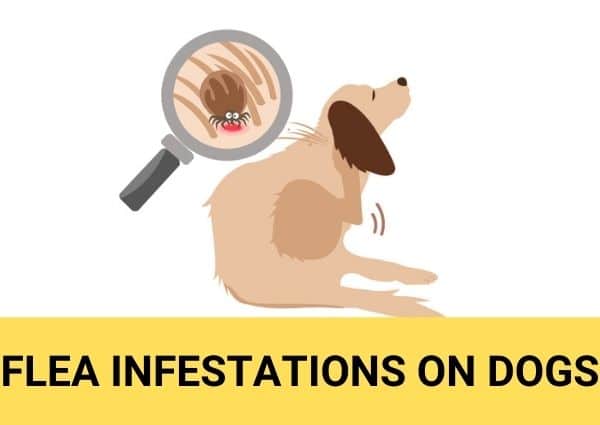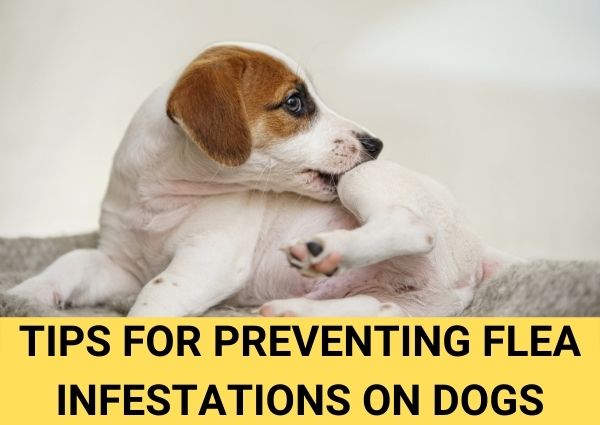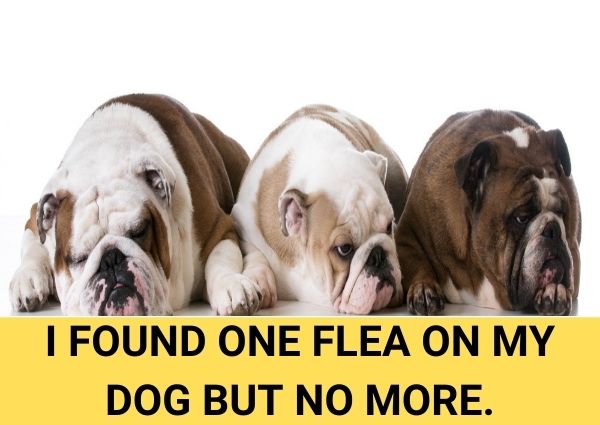Flea infestations on dogs can be quite serious, so it’s important to address them as soon as possible. If you think your dog might have fleas, there are a few key signs and symptoms you can see.
In this blog post, we will discuss the most common ones so that you can determine whether or not your dog needs treatment. We’ll also provide some tips on how to get rid of fleas on dogs. Keep reading for more information!

Symptoms of a Flea Infestation on Dogs.
A flea infestation on dogs can cause many different symptoms. One of the most common is itchiness. Dogs with fleas may excessively scratch their skin or bite at their fur to relieve the irritation. This can lead to hair loss and open sores, becoming infected.
Fleas may also cause your dog to lose appetite and lose weight. In severe cases, flea-infested dogs may develop anemia due to blood loss.
If you notice any of these symptoms in your dog, it’s essential to take them to the vet for treatment. Flea infestation on dogs can be painful and dangerous for your pet, so don’t wait to get help.
Treatment Options for Flea Infestations on Dogs.
Fleas are tiny parasitic insects that thrive by feeding on the blood of animals. While fleas are primarily a nuisance, they can also transmit diseases and cause anemia in young puppies.
A flea infestation can be challenging to eliminate, but several treatment options are available. The most common approach is to apply a spot-on treatment directly to the dog’s skin, and this product typically contains an insecticide that kills fleas and ticks on contact.
Another option is to take oral medications monthly and prevent fleas from reproducing. A less common approach is to use a flea bomb, which releases pesticides into the air and kills fleas throughout the home. Whichever approach you choose, it’s essential to follow the instructions carefully and be patient, as it can take several weeks to see results.
If you suspect your dog has fleas, the first step is to take them to the vet for a diagnosis. Once fleas have been confirmed, a few different treatment options are available.
Over-the-Counter Treatments.
There are some over-the-counter treatments available for flea infestations on dogs. The most common is a spot-on treatment applied directly to the dog’s skin and typically contains an insecticide that kills fleas and ticks on contact. Another option is to take oral medications monthly and prevent fleas from reproducing. A less common approach is to use a flea bomb, which releases pesticides into the air and kills fleas throughout the home.
Prescription Treatments.
If over-the-counter treatments don’t seem to be working, your vet may prescribe a more vital medication. Capstar’s oral medication is the most common prescription flea treatment, killing fleas within 24 hours.
This medication is safe for dogs and puppies over four weeks old, but you must give it daily until the flea infestation is gone.
Other prescription options include topical treatments, such as Advantage and Frontline, applied directly to the dog’s skin. These products kill fleas on contact and continue to work for several weeks.
Whichever treatment you choose, it’s essential to follow the instructions carefully and be patient, as it can take several weeks to see results. In the meantime, you can take some steps to prevent fleas from coming back. These include regularly vacuuming your home and using a flea comb on your dog to remove any eggs or larvae that may be present. It would help if you also washed your dog’s bedding in hot water, and taking these precautions can help keep your dog flea-free for good.
Natural Remedies.
A few options are available if you’re looking for a more natural approach to flea control. One is to use a mixture of water and vinegar, which can be sprayed on your dog’s fur and help repel fleas. Another option is to make a flea collar by soaking a bandana in lemon juice or eucalyptus oil. This can be placed around your dog’s neck and help keep fleas away.
Tips for Preventing Flea Infestations on Dogs in the Future.
There are a few things you can do to prevent flea infestations on your dog in the future:
- Always check your dog for fleas after they’ve been outside. If you see any fleas, remove them immediately.
- Please keep your dog’s coat clean and brushed; this will help remove any fleas that may be hiding in their fur.
- Make sure to treat your dog with a flea preventive medication regularly, which will help keep fleas from taking up residence on your dog in the first place.

By following these simple tips, you can help to prevent flea infestations on your dog in the future.
Vacuum Regularly to Prevent Flea Infestations on Dogs.
While flea infestations on dogs are most commonly seen in the summer months, they can happen year-round. These pesky insects are not only a nuisance but can also transmit diseases and cause other health problems for your pet.
One of the best ways to prevent flea infestations is to vacuum regularly. Fleas thrive in warm, moist environments, so vacuuming helps to remove their hiding places and eliminates their food source.
Be sure to vacuum all carpets, furniture, and floors where your pet spends time. In addition, you should empty the vacuum bag after each use to prevent the fleas from escaping back into your home.
Regular vacuuming is an essential part of flea control and can help to keep your home flea-free.
Use a Flea Comb on Your Dog.
A flea comb can be a valuable tool in the fight against fleas. Fleas are small, wingless insects notorious for their ability to bite and cause irritation. They can quickly become a nuisance in the home, and their bites can be painful for humans and animals.
Pets are particularly susceptible to fleas, as they often spend time outdoors, where fleas are more likely to be present. A flea comb can help remove fleas from your dog’s coat, and it is an effective way to prevent a flea infestation from taking hold.
Brush your dog’s fur with the flea comb, paying particular attention to areas where fleas are most likely to congregate, such as the tail’s back, belly, and base.
Any fleas that are found should be removed and disposed of immediately. Regular use of a flea comb is essential for preventing flea infestations on your dog.
Wash Your Dog’s Bedding in Hot Water Once a Week.
Another critical part of preventing flea infestations is regularly washing your dog’s bedding in hot water. Fleas thrive in warm, moist environments, so washing your dog’s bedding in hot water helps to remove their hiding places and eliminates their food source.
In addition, washing your dog’s bedding in hot water will help to kill any fleas that may be present. Be sure to wash all of your dog’s bedding, including their blankets, pillows, and toys, in hot water at least once a week.
Taking these precautions can help keep your dog flea-free for good.
Spray a Mixture of Water and Vinegar on Your Dog’s Fur.
Vinegar is a natural flea repellent; you can use it to help keep fleas away from your dog. Mix equal parts of water and vinegar, and then spray the mixture on your dog’s fur.
The vinegar will help repel fleas, and the water will keep their skin from drying out. Avoid spraying the mixture on your dog’s face, as the vinegar can irritate their eyes. This simple remedy can help keep fleas away from your dog and prevent a flea infestation from taking hold.
Soak a Bandana in Lemon Juice or Eucalyptus Oil and Place It Around Your Dog’s Neck.
Lemon juice and eucalyptus oil are natural flea repellents, and you can use them to help keep fleas away from your dog. Soak a bandana in lemon juice or eucalyptus oil and place it around your dog’s neck. The lemon juice or eucalyptus oil will help repel fleas, and the bandana will keep their skin from coming into contact with the mixture. This simple remedy can help keep fleas away from your dog and prevent a flea infestation from taking hold.
Make a flea trap out of a bowl of soapy water. Fleas are attracted to the heat and carbon dioxide that humans and animals emit, so you can use a bowl of soapy water to make a simple flea trap. Place a bowl of soapy water near where your dog spends most of its time, and the fleas will be drawn to the bowl and drown. This simple remedy can help to reduce the number of fleas in your home and prevent a flea infestation from taking hold.
Apply Spot-on Treatment Monthly.
Spot-on treatments are a popular and effective method of flea control. These treatments are applied to the back of your dog’s neck, and they work by releasing a chemical that kills fleas. Spot-on treatments are available from most pet stores and should be applied monthly for best results. Spot-on treatment can help keep your dog flea-free and prevent a flea infestation from taking hold.
Oral Medication Monthly.
Oral medications are another popular and effective method of flea control. These medications are taken by mouth, and they work by killing fleas from the inside out. Oral medications are available from most pet stores, and you should take them monthly for the best results. Using an oral medication can help keep your dog flea-free and prevent a flea infestation from taking hold.
As you can see, there are several simple steps that you can take to prevent a flea infestation on your dog. Taking these precautions can help keep your dog flea-free for good.
The best way to deal with a flea infestation is to prevent it from happening in the first place. You can do this by using a monthly spot-on treatment or oral medication, regularly vacuuming your home, and washing your dog’s bedding. It would help if you also combed your dog with a flea comb to remove any eggs or larvae. Taking these precautions can help keep your dog flea-free for good.
Flea infestations on dogs can be challenging to deal with, but many effective treatment options are available. Be sure to consult with your vet to choose your pet’s best course of action. And don’t forget to follow the prevention tips listed above to keep fleas away for good!
As you can see, there are some simple and practical steps that you can take to prevent a flea infestation on your dog. Taking these precautions can help keep your dog flea-free for good. If you are dealing with a flea infestation, consult your vet to choose your pet’s best course of action. And don’t forget to follow the prevention tips listed above to keep fleas away for good!
If you have any questions or concerns about flea infestations on dogs, be sure to speak with your vet. They will be able to provide you with more information and resources on dealing with this problem.
I Found One Flea on My Dog but No More.

Fleas are tiny, dark-colored parasites that feed on the blood of mammals and birds. Fleas are a nuisance to their hosts and can cause severe skin irritation. A flea infestation on a dog can be challenging to detect because fleas are small and agile.
However, fleas can often be seen moving around on the dog’s skin or fur. If you find one flea on your dog, many more fleas are likely to present. Just one flea can signify a problem because fleas reproduce rapidly.
A female flea life cycle can lay up to 50 eggs per day, and these eggs can hatch within 12 days. Within a few weeks, a flea infestation can quickly become out.
How Do I Know if My Dog Has Fleas?
There are a few signs that you can look for to see if your dog has fleas. These include excessive scratching, biting, or licking at the skin; small black dots on the skin; and restlessness. You must take your dog to the vet if you notice any of these signs.
How Can I Prevent My Dog From Getting Fleas?
The best way to prevent your dog from getting fleas is to use a monthly spot-on treatment or oral medication, vacuum your home, and wash your dog’s bedding. It would help if you also combed your dog with a flea comb to remove any eggs or larvae.
What Should I Do If My Dog Has Fleas?
If you find that your dog has fleas, the best thing is to take them to the vet for a check-up. Your vet will be able to prescribe the best course of treatment for your pet. In the meantime, follow the prevention tips listed above to keep fleas away for good!
Did you find this article helpful? Please share it with your friends to help them prevent flea infestations on their dogs! And be sure to check out our other articles for more tips and advice on keeping your dog healthy and happy. Thanks for reading.